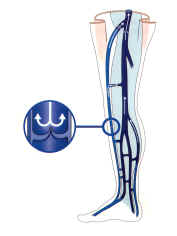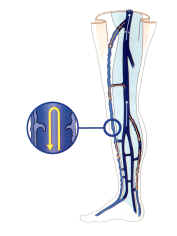The circulatory system - arteries and veins make up a part of our circulatory system. The blood circulation starting from the heart is carried to tissues and organs through arteries, and then returns to the heart through veins. The returning blood needs to overcome gravity. The return of blood is facilitated by contracting muscles and the valve system. Meanwhile, the oxygen, which is abundant in the blood, is used by tissues and organs, resulting in little oxygen remaining in the returning blood. Therefore, while incoming blood is lighter red in color, the returning blood is darker.
The valves in the veins prevent the backward flow of blood, ensuring one-way circulation. If the vein walls become tense and less elastic, the valves weaken. Weakened valves can cause blood to leak back or even flow in the opposite direction. In such a case, blood may accumulate in the veins, leading to their enlargement and swelling. This results in the accumulation of blood in the legs and eventually the development of varicose veins.
Experts cannot precisely explain why the valves weaken, fail to function, or why the veins stretch.
In a FASEB presentation at Heidelberg University (Germany) in October 2011, it was written that a single protein linked to the DNA control gene (transcription factor AP-1) initiates the process of varicose vein formation. You can access the relevant article from here.
Research author Ph.D. Thomas Korff stated that their findings would lead to studies focusing on the underlying mechanisms of these common but dangerous vascular diseases in the long term, and they hoped that this would lead to the development of drug therapies that would greatly improve the quality of life.


Below, you can examine the high-risk groups for the likelihood of developing varicose veins:
- Women are twice as likely as men to develop varicose veins in their legs.
- Varicose veins are generally genetic.
- The risk of developing varicose veins is higher in overweight/obese individuals.
- Women are at a higher risk of developing varicose veins during pregnancy compared to other periods of their lives. This is because there is more blood during pregnancy than in normal processes, leading to extra pressure in the circulatory system. Hormonal changes and fluctuations in hormone levels cause relaxation/expansion of blood vessel walls. Both of these factors increase the risk of varicose veins. As the uterus grows, there is more pressure on the mother's pelvic vessels. Generally, varicose veins that have formed during pregnancy disappear after pregnancy ends. (They do not always disappear or all varicose veins may not disappear)
Some occupational groups, especially those who stand for long periods or travel frequently, are at risk.





 Login with Google
Login with Google